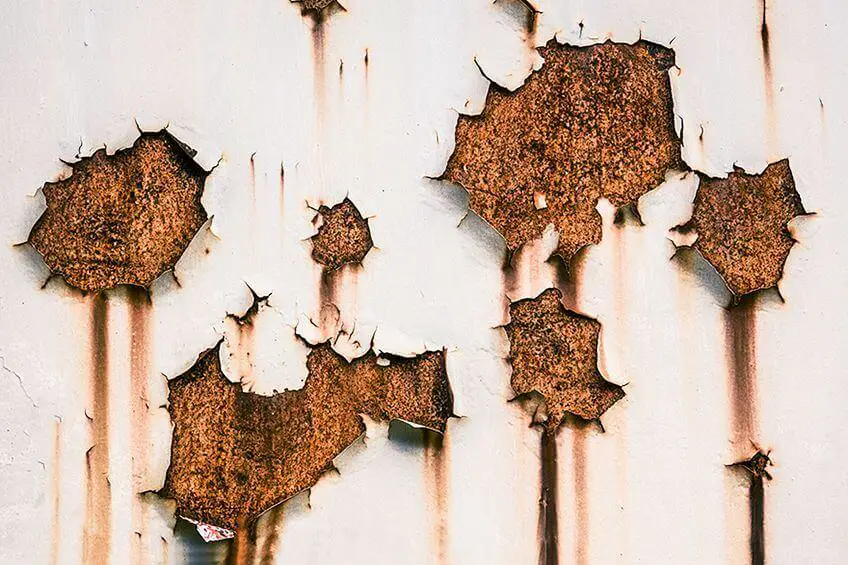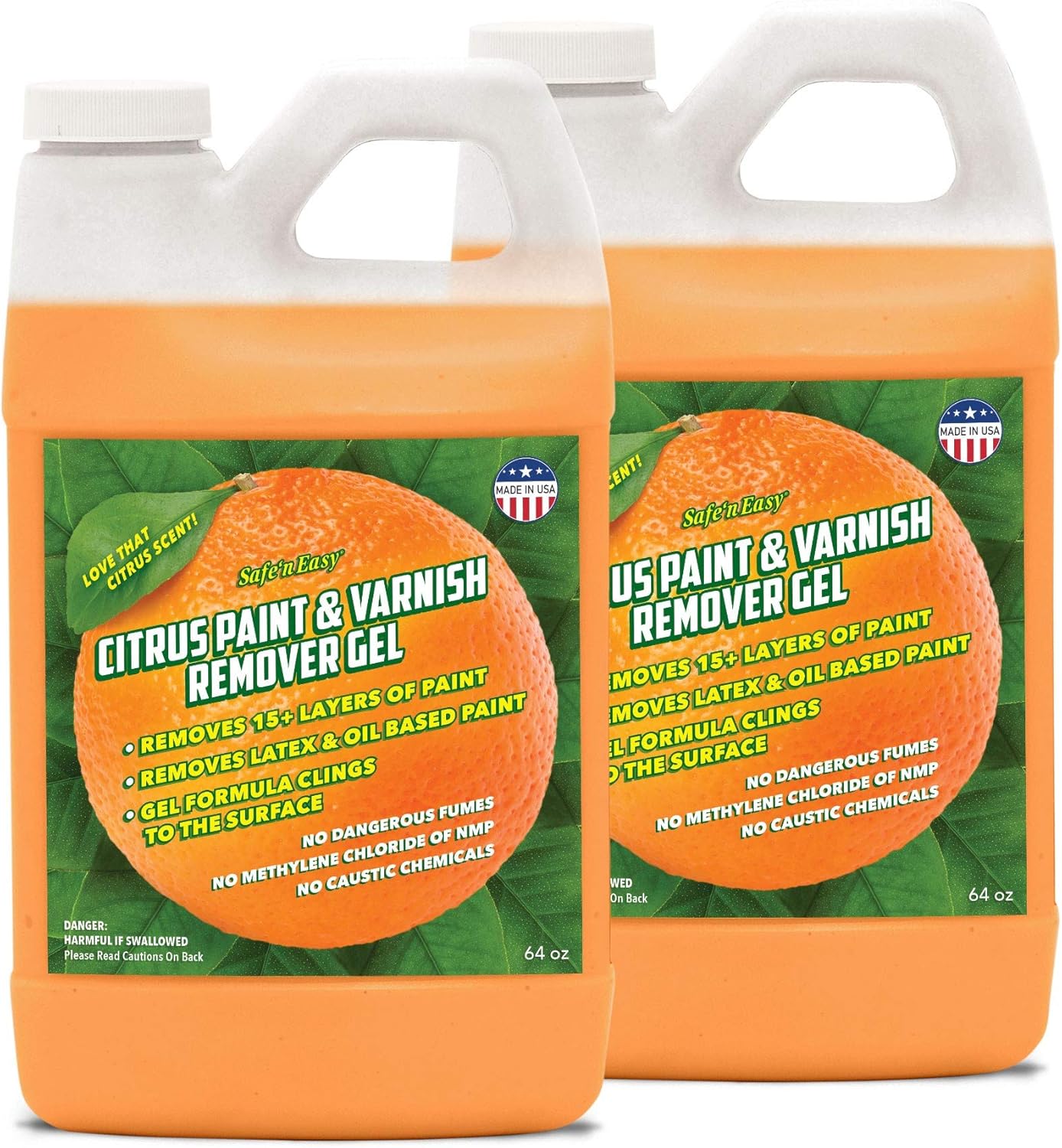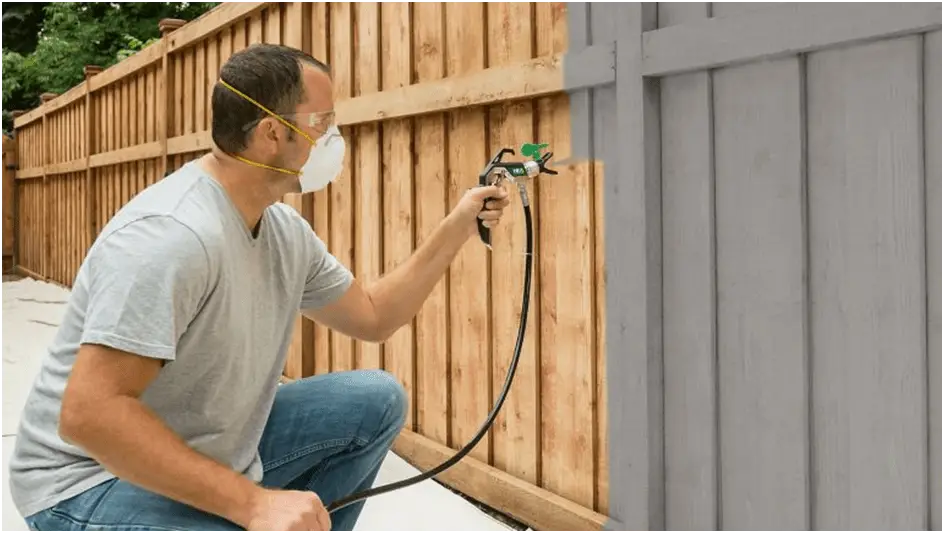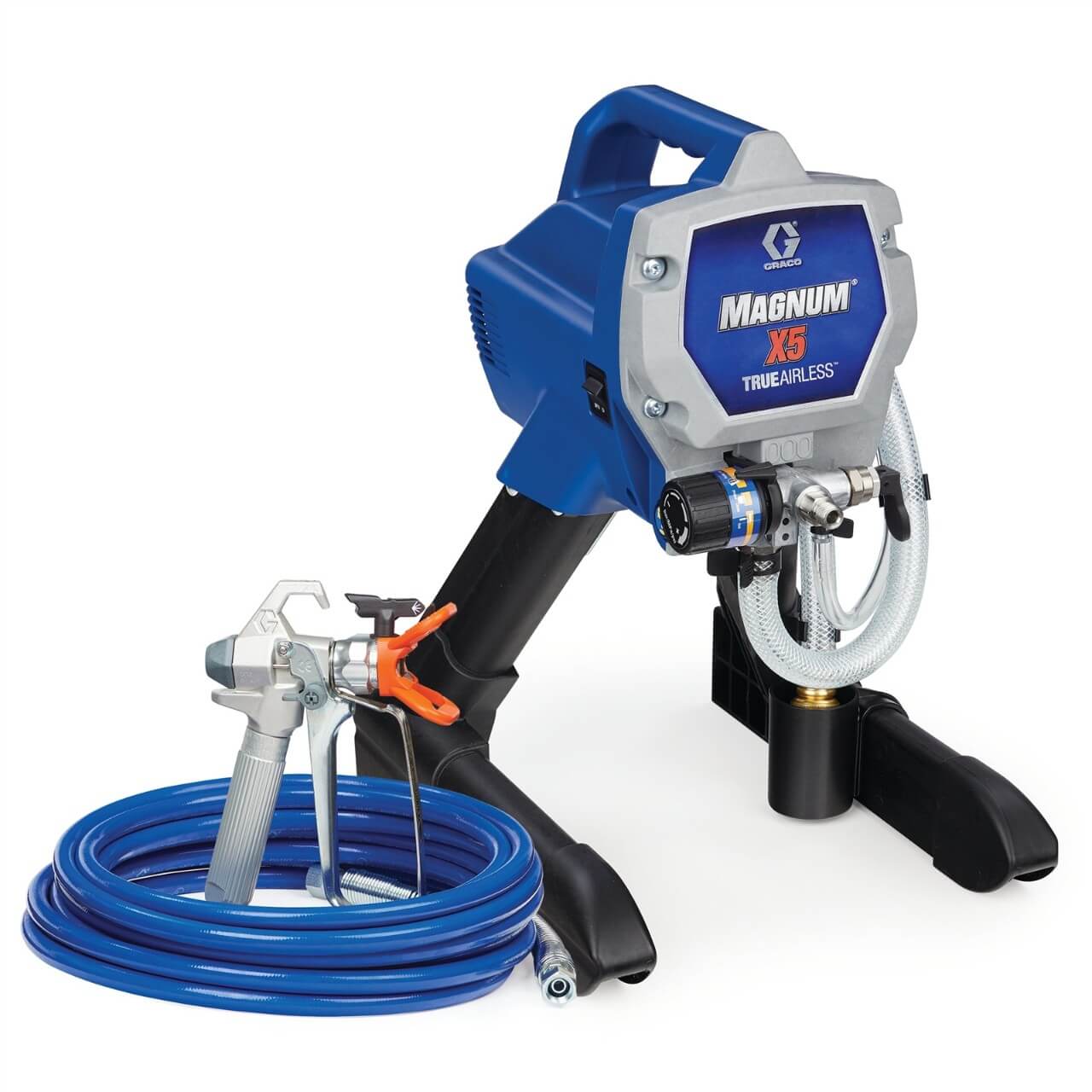If you have ever tried to remove paint from a metal surface, you know how difficult and time-consuming it can be. There are many methods to remove paint from metal, most are labor-intensive and frustrating.
To remove paint from metal like a pro, there is no better alternative than using the best metal stripper.
You can try using any DIY solution like varnish or shellac. But, once you experience the best stripper for removing paint from metal, you won’t be looking for another option.
Below is a quick list of all of our best products. Keep scrolling to learn more about choosing and using the best paint stripper for metal.
- Dumond SmartStrip Advanced Paint Remover – Best Overall
- Citristrip Paint & Varnish Stripping Gel – Best All-Purpose
- Rust-Oleum Aircraft Remover – Best Value
- Safe ‘n Easy Citrus Paint & Varnish Remover Gel – Highest Rated
- Goof Off FG653 Professional Strength Remover – Budget-friendly
- Wagner Spraytech Heat Gun
- Bates Paint Scraper 5-in-1 Tool
Luckily, there are ways to remove this painting without taking time off work and canceling all your future plans!

By finding the right product to replace this pesky paint, you will be able to spend more time painting the item or simply erase the mistakes of a previous painter.
We’ve done over 20 hours of exhaustive research and found the 7 best paint remover for metal so you don’t have to.
Table of Contents
Best Paint Stripper for Metal – Our Top Picks
There are a variety of chemical-based paint strippers available, some more toxic than others. There are also different formulations to tackle different types of paint or painted surfaces, so before purchasing a stripper, always check that it is the right one for your project.
While paint strippers can be a great help with the tedious task of removing paint, they need to be used with care.
Consult the manufacturer’s guidelines for safe use, which should be clearly printed on the can or bottle, and follow all instructions, including eye or respiratory protection, ventilation, and skin precautions.

Still, while paint strippers can involve noxious fumes and use powerful chemical formulations, they do reduce the work and grease required to remove multiple layers of paint, and if you tackle enough DIY painting projects, you’ll likely need to use one. sometime.
So you can consult our suggestions of the seven best paint stripper for metal to make the purchase.
1. Dumond SmartStrip Advanced Paint Remover
Dumond Smart Strip is a water-based stripper and an innovative revolution for paint strippers as it is safe and can be applied to any substrate or environment.
The formula of this paint remover is methylene chloride-free, non-carcinogenic, non-toxic, and non-caustic.
It can effectively remove multiple layers of paint, such as oil and water-based paints, acrylics, varnishes, urethanes, and even old lead paint.
Dumond Smart Strip Paint Stripper is versatile and works on exterior surfaces such as wood, brick, stone, concrete, plaster, metal, plastic, glass, fiberglass, etc. You only need to apply Smart Strip for 24 hours and you will get the job done!
However, we believe that this Dumond Chemicals product will make you feel completely safe using it.
This stripper stands out for being biodegradable. As its ingredients are measured in standard dosages, it will not harm your skin when you touch or use it.
In addition, Smart Strip Advanced Paint Remover has been modified to be odorless, an element that everyone can appreciate. You know, no one likes the strong smell of paint remover!
According to the manufacturer, this product can be used for many paint surfaces, such as lead-based paint, marine paint, etc. And that too has been verified and confirmed by consumers.
2. Citristrip Paint & Varnish Stripping Gel
Citristrip is a powerful, commercial-grade paint remover with a gel-like formula that stays wet and active for a full day, allowing you to remove multiple layers of paint in one easy step.
Contains no harmful chemicals like methylene chloride or N-methyl pyrrolidone. Citristrip is non-caustic and is an essential tool for internal paint removal.
It can be a long-lasting gel stripping agent for removing multiple layers of latex and oil-based paint, varnish, lacquer, enamel, polyurethane, shellac, acrylics, and epoxy from wood, metal, and masonry surfaces.
Citristrip QCSG801 is suitable for indoor use. The stripping gel will resemble thick yogurt and will scratch multiple layers of paint for about 24 hours. If it is spread on the painted metal surface, let it sit for a few hours before cleaning it off.
However, the stripper will eat away at nitrile, rubber, and latex gloves, so care must be taken when handling it: wear only gloves made from butyl rubber.
3. Rust-Oleum Aircraft Remover
Rust-Oleum Aircraft Remover is the perfect solution for stripping any metal surface on cars and trucks.
It is fast-acting and efficient at removing all types of finishes without damaging your vehicle! This product will not corrode metal after a few minutes if you follow the directions correctly.
Fortunately, this remover is unique in that it is non-flammable and therefore suitable for use on metals that are around hot objects; do not fear the risk of fire.
However, make sure the surface to be treated is free of glue because the paint remover will eat it away.
Rust-Oleum is a gel-like stripper and will not be hazardous to methylene chloride or bases, and will not be a fire hazard. Also, the remover will be very useful for removing epoxy, polyurethanes, and glue. Once again, this stripper is eco-friendly.
This paint remover is also inexpensive and easy to use as it will be ready in 10-15 minutes, especially on metal, vehicles, or bikes. However, avoid getting the gel on your skin as it will cause a burning sensation or irritation.
4. Safe ‘n Easy Citrus Paint & Varnish Remover Gel
Safe ‘n Easy Citrus Paint & Varnish Remover Gel is an excellent product to use if removing multiple layers of oil, latex, and acrylic-based coatings.
With Safe ‘n Easy Citrus’ citrus formula that removes up to 15 layers in one application without harmful chemicals like methylene chloride or NMP, this will be the best choice for you!
Not only does it smell great, but with its safe ingredients, there’s no need to worry about the harsh fumes damaging your lungs and you also don’t have risk-averse effects on other surfaces around which you’re trying to remove paint.
Safe ‘n Easy Citrus Paint and Varnish Remover Gel can clean away any remaining dirt and stains. It was created to make your DIY projects more accessible, safe, and fun! It is water-based, non-caustic, and biodegradable.
This product can be applied by brush or hand spray to virtually any surface including wood, brick, stone, metal: plaster, tile, deck, porcelain, etc.
Get yours in ½ and quart containers at the best prices online today! This all-purpose paint has been created specifically for DIYers who want their project to be safe.
5. Goof Off FG653 Professional Strength Remover
Goof-Off is a great paint stripper for metal or wood, including oak tables that have varnish or coatings and stains; these will peel off and bubble quickly; will remove both epoxy and paint from metal equally; It is a complete epoxy or paints stripper.
It is not only effective but also a quick and convenient paint remover for cars.
No matter if you have to deal with old paint or dried paint, this paint remover can remove all kinds of surface paint efficiently. You can use it for multiple types of surfaces including metal, wood, glass, brick, concrete, grout, fiberglass, hand tools, and auto body stripping.
However, even though the epoxy and paint remover will be easy to apply, some people report having problems related to bottle clogging.
Also, the stripper could release some dangerous gasses and might need some specialized equipment.
6. Wagner Spraytech Heat Gun
Wagner is one of the leading manufacturers of high-quality, advanced paint applicators. And the brand’s Wagner Heat Gun is certainly no exception.
So whether you’re a professional or the occasional DIYer, this product can help you achieve quality results by effortlessly smoothing a wide range of materials for successful removal.
This state-of-the-art spray gun operates at high temperatures ranging from 750 to 1,000 degrees Fahrenheit.
Consequently, it is possible to use it for various household tasks, including paint removal, by managing its heat settings. but how does it work?
Simply fill the remover into the gun and spray it onto any suitable surface. You’ll find that it has dual fan settings, making it easy to tweak the speed based on different projects.
Additionally, engineers have added support for hands-free operation and the safety of your hot nozzle.
Speaking of the nozzle, we found that it is corrosion resistant and durable for a long time of use.
And especially nice is the fact that it gives a precision result by spraying the paste inside the required area. That is, you will not need chemicals to remove the paint; Let the paste dry and then scrape it off.
Plus, after work, consumers can hang the gun on its hook for easy storage.
7. Bates Paint Scraper 5-in-1 Tool
The Bates Putty Knife Paint Scraper makes repainting easy because it has a stainless steel blade that easily and consistently scrapes paint off your project.
Highly portable, versatile, and packed with loads of features, the Bates Choice Paint Scraper is an inexpensive option best suited for light DIY projects.
Convenient to use and known for its many uses, this product ensures that you can use it to remove paint from various surfaces with ease.
These Bates Choice scrapers made our list, thanks to their superior finish and easy-to-use performance. Unsurprisingly, consumers can use it for repair and restoration tasks as it gives a polished look to the surface.
That said, it’s also useful as a putty knife, screwdriver, case opener, and crown molding remover, among other things. Therefore, it is a valuable acquisition, which means that you will not need to buy additional tools.
However, there is one similarity between the two, which is their rust-resistant coating. Overall, these premium paint scrapers are perfect for remodeling, since having a sprayer and stripper isn’t enough.
Best Paint Remover for Metal Buying Guide
Now let’s move on to the buyer’s guide section; We tell you all about the essential characteristics of paint strippers. So keep these points in mind before heading to the market.
Metal strippers come in different formulations that make up the strength and reliability of the product.

There are also many factors you need to consider in order to find the best stripper to get the job done right.
When shopping for a paint stripper, it’s important to consider a few factors, including the type of paint stripper, the materials it works with, and the safety of its use. Later, learn about these and other important features of paint strippers.
We strongly recommend reading this part to the end; otherwise, you may discover a thing or two. Let’s start.
What to Look for in a Paint Stripper
1. Type
Most people don’t know that there are actually four main types of paint strippers: solvent, caustic, biochemical, and non-VOC paint strippers.
Each type has its strengths and weaknesses, so understanding the differences between them is necessary to choose the best paint remover for metal, epoxy, or even polyurethane.
2. Health and safety
Always keep your safety first when purchasing and using paint strippers. Some products include methylene chloride, and while it has excellent fast paint removal properties, it is very dangerous to general health.
If you come in contact with this for a short time, it can temporarily decrease your blood’s ability to carry oxygen.
The safety factor for health is the prerequisite that you should pay attention to. As the stripper is a chemical compound with a high detergent capacity, the dangerous thing that can happen to you is unforeseen.
In order to ensure health safety, you must first equip yourself with protective equipment. Goggles, masks, and protective gloves will be essential.
Also, consider the type of paint removers you use when shopping for gloves. Some strong chemicals can corrode some common types of gloves like latex, silicone, etc.
Then read the manufacturer’s manual carefully. Some types of strippers will have special requirements, such as the need for high ventilation, need for dilution, need 24 hours to work, etc. So, do as you are guided!
3. Surface And Materials
Consider the surface area of the material you are about to remove.
If you choose a stripper that does not suit the materials, there are two possibilities. One of them is that your stripper cannot remove the paint from that material. And another is that the chemical ingredients in the paint are too strong, destroying the material you want to remove from the paint.
So, carefully consider the materials you’ll be disposing of to make sure you buy the right stripper and don’t spend money and make it worse.
4. VOCs
Like the paint, varnishes, and lacquers they remove, strippers can remove VOCs that can be harmful to inhale and cause nose, throat, and eye irritation.
While VOCs are less of a concern when working outdoors, they can be harmful when working indoors, especially if ventilation is limited.
High VOC strippers often use harsh chemicals in their formulation. If you plan to work indoors, look for a paint stripper that doesn’t use chemicals like methylene chloride, which produces high VOCs.
5. Speed
It’s best to choose a stripper that doesn’t dry quickly if you intend to remove paint from a larger surface area. It is best to go meter by meter.
Simply apply the remover, remove the layer, clean the surface and repeat this until you are satisfied with the result.
Some products need to sit for 24 hours to work long enough. This means you can cover a larger surface area and leave the remover on overnight before wiping off the paint the next day.
Cleaning smaller objects is best with quick or aggressive paint strippers. The paint will quickly come off so you can repaint the object in your hand.
What is a Paint Stripper?
Paint stripper is a chemical solution formulated specifically to remove paint from the surface of wood, metal, and even masonry materials such as brick or concrete.
Paint remover generally refers to a chemical used to remove paint from a surface.
These chemicals come in a variety of different formulations and each has its pros and cons. These chemicals are usually applied with a brush and are effective at completely removing a ton of different types of paints and coatings.
Before we look at the best paint stripper for metal, let’s take a look at some of the different types of chemical paint strippers.
Different Types of Paint Strippers
There are four types of paint strippers. Each of them has its own properties that make it suitable for specific surfaces.
Some are suitable for polyurethane; others are suitable for removing epoxy, etc. Let’s quickly describe the types of paint strippers below:
Solvent-Based Paint Strippers
Solvents are the most common and versatile type of paint stripper. They are made with powerful chemicals that break the bond between the paint and the surface.
These paint strippers are effective at removing paint, epoxy, and polyurethane from wood, masonry, and metal surfaces, although they may contain very high VOC ingredients such as methylene chloride.
Solvent-based strippers are designed to break the bond that exists between the painted object and the paint on it. Solvent-based stripper accomplishes this by causing the paint on the object to swell, thereby weakening the bond between the paint and the object.
One of the most common ingredients in solvent-based strippers is methylene chloride. They are very good at removing thick layers of paint buildup and do not cause any damage to the wood or the surface of the project piece.
Caustic Paint Strippers
Caustic paint strippers interact with the paint on a chemical level to convert the paint into a more soapy substance, which loosens the bond between the paint and the target surface.
These alkaline strippers should be neutralized with a vinegar and water solution after use to return the surface to a neutral pH of 7.
Sodium hydroxide reacts with the oily ingredients in the paint and causes the paint to begin to break down.
Biochemical Paint Strippers
Biochemical paint strippers are less aggressive than solvent and caustic strippers because they are made with a mixture of plant-based solvents and an organic compound known as N-methyl 2-pyrrolidone.
These strippers will not work with epoxy or polyurethane, although they are suitable for water- and oil-based paints on masonry, metal, or wood surfaces.
Although milder than solvents and caustic paint strippers, biochemical strippers are still powerful and can cause adverse effects on the respiratory and reproductive systems, so be sure to wear the proper safety gear when working with any paint stripper. painting.
Zero VOC Paint Strippers
Low or zero VOC paint strippers are the safest choice if you are concerned about the harmful effects of some of the other types.
They are made with natural solvents, like benzyl alcohol, instead of more caustic chemicals like NMP or methylene chloride. However, there is a tradeoff for the more environmentally friendly formula; These strippers tend to require more time, applications, and scraping to completely remove the paint than older, more toxic formulations.
Use these paint removers on the water or oil-based paint that has been applied to a metal or masonry surface. They also work on wood surfaces, but results may vary depending on the paint and type of wood.
Tips for Working With Paint Stripper
In addition to the application tips for the different types listed above, follow these practices for the safe and effective use of any paint stripper:
- When using ready-to-use paint strippers, the first thing you should do is read the label. The label will contain all the vital information such as precautions to take, preparation requirements such as shaking or stirring the stripper before use, how long the stripper should be left on the surface, and many others.
- Whichever stripper you plan to use, it is important to protect your health by wearing protective clothing. Cover skin, wear respirators that protect you from solvent vapors and wear safety glasses and gloves.
- It is also important to keep the area well ventilated so process vapors can escape. If you’re stripping removable fixtures, like cabinet doors, it’s best to take them outside of the stripper. If the stripping cannot be taken outside, comply with the OSHA standard exposure limit. The air in the room should be changed 7 to 10 times an hour by using a fan that will blow the fumes out of the window.
- Strippers can be applied using a brush, spray bottle, roller, or sprayer. The appropriate applicator will depend on the consistency of the stripper and the size of the surface to be stripped.
- Allow plenty of time for the stripper to do its job. The time you have to let it sit is indicated on the label. Once the time is up, start scraping the goo into a bowl.
- The last step is to neutralize and wash the surface after removing the entire layer of old paint. Follow the manufacturer’s instructions for this procedure. After this, allow sufficient time for the surface to air dry and heat dry before running further surface preparations and painting a new coat.
Frequently Asked Questions (FAQs)
What is the Best Way to Remove Paint?
There are three most common ways to remove paint that you can choose from chemical stripping, heat burning, and sanding.
Sanding is a much-appreciated option if the surface of your material is flat and not rough. This method will require you to use a lot of force to get rid of the paint, which is challenging but relatively quick.
What about removing paint on rough surfaces that have a lot of nooks and crannies? Chemical strippers will do it! Strippers will easily clean rougher surfaces, but it will take a while for the chemicals to soak through and loosen the paint.
Burning with heat is a method that will require you to equip a heat gun to heat the paint directly and peel it off. This method can only be used with certain types of materials such as metal, wood, etc, and is not recommended for materials that are prone to melting due to heat.
What is the best way? The answer depends on the type and surface of your materials.
Stripping vs Sanding: which one is better?
Stripping is a better option as it saves you a lot of energy and minimizes the paint sanding that comes with the sanding process.
Also, the use of chemical strippers will not scratch the surface of the wood, unlike the sanding process.
Can I paint strippers on all surfaces?
Not really. While most paint strippers are labeled as usable on a variety of surfaces, some are formulated for specific surfaces like wood or metal.
It is important to check what the stripper is for. For stripping wood, make sure you get the best wood stripping products. The best paint remover for metal will work best for a metal surface.
How to use a paint stripper?
Use a paint stripper by first blocking off the area to prevent children, pets, and others from accidentally touching the stripper or breathing in fumes. Put on PPE, including long pants, a long-sleeved shirt, chemical-resistant gloves, a respirator, and safety glasses.
Apply the paint remover with a disposable brush in short strokes. Be sure to apply the stripper in thick enough layers and in one direction for best results.
After the period of time indicated by the manufacturer’s instructions has passed, scrape the paint and stripper off the surface.
Next, neutralize a caustic paint stripper with a vinegar and water mixture, or simply wash a solvent, biochemical, or low-VOC paint stripper with water.
What is the fastest way to remove paint from metal?
The easiest and most trouble-free way to remove paint from metal is to use the steel stripping compound.
If you are asking about the DIY method, you can boil the mixture of a quarter cup of baking soda or vinegar with a quart of water.
If you are removing paint from the metal pot, boil the ingredients for 15 to 20 minutes.
Then, use tongs and heat-protective gloves to scrape off the metal pieces.
How do chemical strippers work?
When you need to remove paint from a surface, one of the best ways is to use chemical strippers.
Apply this evenly all over and wait 20 minutes or however long the package says for bubbles to form.
Conclusion
Now you are fully prepared to choose the best paint stripper for metal. A good paint stripper can easily remove paint and varnish to prepare an old piece of furniture or other material for restoration or painting.
Whether you want to remove paint from metal, wood, masonry, or any other surface, this guide will provide you with some of the best products you can use to get the job done to your expectations.
Keep in mind that you should choose the best paint stripper based on safety factors, surfaces and materials, and paint thickness.
All the products presented in this publication are of good quality, high performance, and do not contain harmful compounds that could put your health at risk.
Paint removal should always be done in a well-ventilated area. You should also wear protective gloves and eye protection whenever you use a paint stripper. Your safety is important.











Leave a Reply